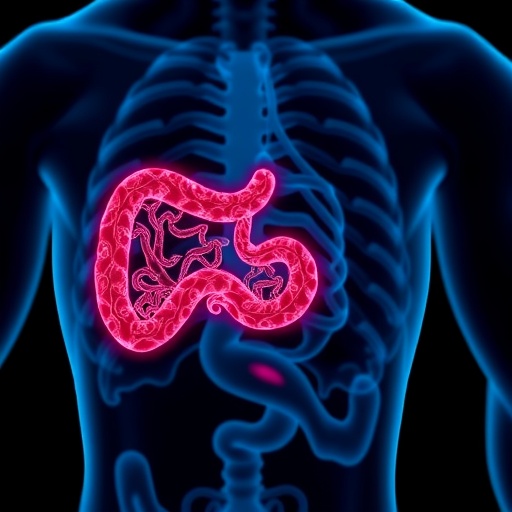In a groundbreaking systematic review and meta-analysis published in the International Journal of Obesity, researchers have unveiled pivotal insights into the detrimental physiological consequences of laparoscopic vertical sleeve gastrectomy (LVSG) on esophageal function. Despite the undeniable efficacy of LVSG in inducing significant body mass index (BMI) reduction, this study exposes alarming postoperative impairments in lower esophageal sphincter pressure (LESP) and distal muscular strength (DMS), critical parameters governing esophageal barrier integrity. These findings cast a shadow over the long-term safety profile of LVSG with far-reaching implications for postoperative surveillance and patient care in bariatric surgery.
LVSG, a widely adopted bariatric procedure, reshapes the stomach to limit food intake and promote weight loss. Yet, the esophagus-lower esophageal sphincter (LES) axis has remained under-explored until now, particularly regarding direct objective measurements of functional alterations pre- and post-surgery. Employing esophageal function tests (EFTs) – including high-resolution manometry and pH-impedance monitoring – the researchers systematically collated data to reveal substantive declines in LESP and DMS following LVSG. This dynamic failure compromises the LES’s role as a critical anti-reflux barrier, enabling gastric contents to reflux into the esophagus and provoke mucosal injury.
Gastroesophageal reflux disease (GERD), characterized by the reflux of stomach acid causing esophageal symptoms and injury, emerges as an almost inevitable clinical sequela following these observed sphincteric dysfunctions. The meta-analysis evidences not only a significantly elevated incidence of GERD symptoms post-LVSG but also a troubling increase in erosive esophagitis (EE), which represents progressive esophageal mucosal damage. More ominously, these acute changes contribute to the development of Barrett’s esophagus (BE), a well-established premalignant condition predisposing patients to esophageal adenocarcinoma – a cancer type with notoriously poor prognosis.
The study underscores a compelling temporal dimension whereby risk escalates significantly beyond ten years post-surgery. This observation is clinically crucial because the majority of existing bariatric outcomes research predominantly centers around short to intermediate-term follow-up. It, therefore, raises urgent concerns about the latent but escalating incidence of BE and esophageal adenocarcinoma over the long term, necessitating proactive, extended postoperative screening protocols specifically targeting these at-risk LVSG populations.
The authors collate evidence affirming that post-LVSG patients manifest a statistically significant rise in proton pump inhibitor (PPI) usage, reflecting either intensifying symptomatic reflux control or prophylactic management of reflux-related complications. The augmented pharmacological burden mirrors an increased healthcare resource utilization, thereby sowing concerns about the sustainable economic impact on health systems. This trend portends a future of escalating costs tied to both medical and potentially revisional surgical interventions aimed at addressing the sequelae of LES compromise.
This complex interplay of physiological alterations also intersects with the anatomical creation of hiatal hernias (HH), which the analysis identifies as significantly more prevalent after LVSG. HH exacerbates reflux pathophysiology by disrupting LES positioning and esophageal hiatus integrity, further impairing esophagogastric junction function. This anatomical disturbance likely amplifies the subsequent development of GERD, affirming a multifactorial and dynamic deterioration of the anti-reflux barrier post-procedure.
Crucially, the comprehensive meta-analysis reflects a collective global experience with over 2,000 patients, lending robustness and generalizability to the conclusions rather than isolated clinical anecdotes. Such a large-scale data synthesis corroborates earlier observational studies and reinforces the imperative for bariatric surgeons and gastroenterologists worldwide to recalibrate their risk-benefit calculus when recommending LVSG.
Clinical decision-making must now incorporate advanced esophageal function testing (EFT) as a standard preoperative assessment tool to identify patients with subtle or overt esophageal motility disorders or pre-existing lower esophageal sphincter pathologies. This stratification could prove transformational in preventing the selection of high-risk patients for LVSG, potentially steering them instead towards alternative bariatric modalities with a more favorable esophageal safety profile.
For those patients already subjected to LVSG, the findings advocate for the institution of vigilant, lifelong endoscopic surveillance focusing on early detection of Barrett’s esophagus or erosive mucosal changes. Such proactive clinical vigilance is vital to intercept the progression to esophageal adenocarcinoma, optimizing patient prognoses through timely therapeutic intervention.
Furthermore, given the progressive LES dysfunction and escalating GERD incidence, revisional bariatric surgical strategies may become increasingly necessary. Selection of these revisions should be highly individualized and guided by a detailed understanding of each patient’s LES physiology, as identified through EFT parameters, to avoid exacerbating reflux symptoms or anatomical disruptions.
At a systemic level, the concerning trends observed should invoke strategic policy responses within healthcare systems. Resource allocation for bariatric surgery must now be balanced against the downstream costs of managing GERD complications, pharmacotherapy, and potential cancer surveillance, emphasizing integrated multidisciplinary care frameworks.
On a research frontier, the meta-analysis paves the way for urgent investigations into the molecular and biomechanical bases of LES weakening post-LVSG. Elucidating mechanisms—whether neurogenic, muscular atrophy, or structural reconfiguration—could yield therapeutic targets aimed at corollary sphincter reinforcement concurrent with or following bariatric alteration.
In resonance with these scientific revelations, the international bariatric community faces a call to action—to refine surgical techniques minimizing LES and esophageal disruption, optimize patient selection algorithms utilizing esophageal functional parameters, and institute standardized long-term postoperative monitoring protocols tailored to mitigate adverse esophageal outcomes.
As bariatrics continues to evolve amidst rising global obesity rates, integrating esophageal function preservation into surgical innovation promises a paradigm shift toward more holistic not only weight-focused but gastroenterologically safe interventions. The balance between sustainable metabolic benefits and esophageal integrity is critical, ensuring life-altering weight loss does not exact an unacceptably high physiological cost.
In conclusion, this definitive review elucidates that LVSG, while powerful against obesity, exacts measurable harm on key esophageal mechanisms governing reflux prevention. The resultant elevation in GERD, Barrett’s esophagus, and potential adenocarcinoma mandates reappraisal of current surgical practices and vigilant, personalized postoperative care. The future of bariatric surgery lies not only in effective weight reduction but also in safeguarding esophageal health—a challenge now illuminated with unprecedented clarity by this landmark meta-analysis.
Subject of Research: Effects of laparoscopic vertical sleeve gastrectomy (LVSG) on lower esophageal sphincter function and gastroesophageal reflux disease (GERD).
Article Title: Impact of laparoscopic vertical sleeve gastrectomy (LVSG) on lower esophageal sphincter pressure (LESP), lower esophageal sphincter length (LESL) and gastroesophageal reflux disease (GERD) using esophageal function tests (EFTs): a systematic review and meta-analysis.
Article References:
Memon, M.A., Yunus, R.M., Alam, K. et al. Impact of laparoscopic vertical sleeve gastrectomy (LVSG) on lower esophageal sphincter pressure (LESP), lower esophageal sphincter length (LESL) and gastroesophageal reflux disease (GERD) using esophageal function tests (EFTs): a systematic review and meta-analysis. Int J Obes (2025). https://doi.org/10.1038/s41366-025-01926-y
Image Credits: AI Generated
DOI: https://doi.org/10.1038/s41366-025-01926-y
Tags: esophageal barrier integrity after surgeryesophageal function tests in bariatric patientsGERD prevalence after LVSGhigh-resolution manometry in LVSG studiesimplications for postoperative care in bariatric surgerylaparoscopic vertical sleeve gastrectomy effectslong-term safety of weight loss surgerylower esophageal sphincter pressure analysisLVSG impact on esophageal functionmeta-analysis on GERD and LVSGpostoperative complications of bariatric surgeryreflux disease and weight loss surgery outcomes





